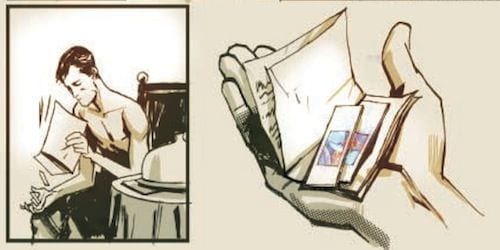
It really just comes down to her coat.
It’s hard not to be lured back into the Bourne Identity. Not the 2002 movie where Matt Damon escapes the US Embassy in Switzerland (escapes a US Embassy!, what a statement for a post-911 world) by craftily clinging by his fingertips while plummeting downwards in a bid to out-drop US Marines. And not the original novel either. Slick as it was, Ludlum’s original novel wrestles with the same dilemma that Hitchcock’s Mr. & Mrs. Smith or his Marnie for that matter which has to do with the erasing of moral functionality that comes with the loss of identity.
Reading Ludlum’s original novel, it’s easy to feel left out to sea, an astonished onlooker while The Patient (Ludlum’s identity-free phraseology for Bourne just post his rescue by the Mediterranean fishing trawler and just prior to his discovering his retrograde amnesia), cavorts through Europe shooting, stabbing and thieving away.
Instead the staging area to Robert Venditti’s superb Homeland Directive, the one Bourne Identity that vectors you in neatly, is the 1988 ABC movie version starring Richard Chamberlain fresh off the set of Thornbirds. The ABC movie remained faithful to the original novel in a way that Paul Greengrass’ sublime reimagining in 2002 did not. And in doing so, Richard Chamberlain reenacts the scene where Bourne saves Canadian economist Dr. Marie St. Jacques (she’s a Canadian government employee in the novel and the 1988 film rather than a post-national European traveler).
It’s slightly more complicated than that. The (by this time) affably amoral Jason Bourne needs to escape pursuers who have tracked him back to his hotel where an international economics symposium is being held. To elude his trackers, Bourne ducks into the event and kidnaps Marie St. Jacques. With her in arm, Bourne’s escape goes smoothly until he hits the parking lot. In a fearsome statement of 1980-level military technology, the assassins train their laser-guided precision sniper rifles on Bourne and Marie. But how did the observation unit assassins know to target Bourne and Marie?
It really just comes down to her coat. Bourne had neglected to pick up Marie’s coat from check-in and in the long, cold dark of a Fall evening in Switzerland, a woman in nothing more than a bright-red evening gown stands out. It was that splash of color. That red-on-black. That tactic of self-branding that always lay at the heart of Ludlum’s novel for me. A theme carried forward from the profound Osterman Weekend wherein Ludlum predicts reality television.
Art from the forthcoming ‘Homeland Directive’
Homeland Directive will offer you an invitation into the same uncharted waters of human identity and bureaucracy, of meaning-versus-value of human lives. The story of CDC researcher Dr. Laura Regan who finds herself the subject of a false flag operation that might have as its sole objective killing her, Homeland Directive is a Great and Powerful meditation on why personhood ought to be prized above politics. And Homeland Directive will simply draw you in.
Sean Konot’s lettering is small and compact. It will push you into that sense of claustrophobia that decorates the best of espionage thrillers; AMC’s recent Rubicon and the BBC’s classic drama Tinker, Tailor, Soldier, Spy. And that sense carries through with Mike Huddleston’s lavish artwork. Cars crush up as they race by, CSI-style lighting spills over every page. And in a magnificent example of intertextuality, Laura’s evening gown shifts color from red to black, as a more somber tone begins to take hold in the story.
But the true centerpiece is Robert Venditti’s story and it’s execution. What’s at stake here is the post-surveillance society. Post-surveillance, which includes the self-actuated surveillance that comes with social media. If anything, Robert has already explored the ramifications of transgressive persistent identity in his earlier works, The Surrogates and its sequel The Surrogates: Flesh & Bone. But what comes after Facebook? Robert has a few ideas, but you won’t simply be reading them in Homeland Directive, you’ll be experiencing them.
In exploring the nature of the relation between the individual, society and the state, one would anticipate Venditti’s Homeland Directive to elevate both the thriller genre and the comics medium. Venditti delivers admirably on both counts. It is a secret joy however, that he also manages to elevate the reader.

![Call for Papers: All Things Reconsidered [MUSIC] May-August 2024](https://www.popmatters.com/wp-content/uploads/2024/04/all-things-reconsidered-call-music-may-2024-720x380.jpg)



